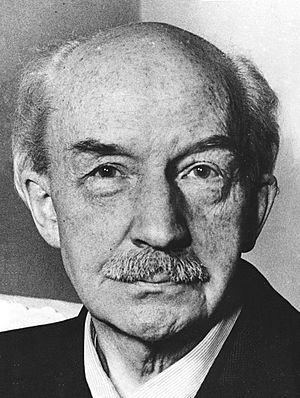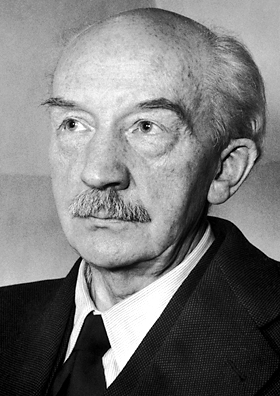Walther Bothe facts for kids
Quick facts for kids
Walther Bothe
|
|
|---|---|

Walther Bothe in the 1950s
|
|
| Born | 8 January 1891 |
| Died | 8 February 1957 (aged 66) |
| Nationality | German |
| Alma mater | University of Berlin |
| Known for | Coincidence circuit Neutron transport theory |
| Spouse(s) | Barbara Below |
| Awards | Nobel Prize for Physics (1954) Max Planck Medal (1953) Pour le Mérite for Sciences and Arts (1952) |
| Scientific career | |
| Fields | Physics, mathematics, chemistry |
| Institutions | University of Berlin University of Giessen University of Heidelberg Max Planck Institute for Medical Research |
| Doctoral advisor | Max Planck |
| Signature | |
 |
|
Walther Wilhelm Georg Bothe (German pronunciation: [ˈvaltɐ ˈboːtə]; January 8, 1891 – February 8, 1957) was a German physicist. He won the Nobel Prize in Physics in 1954 with Max Born.
In 1913, he started working at the new Laboratory for Radioactivity. This was part of the Reich Physical and Technical Institute (PTR). He stayed there until 1930, becoming the director in his last few years.
Walther Bothe served in the military during World War I. He was a prisoner of war in Russia until 1920. When he returned, he developed a special "coincidence method." This method helped him study nuclear reactions, the Compton effect, and cosmic rays. It also helped him understand how light can act as both a wave and a particle. These discoveries earned him the Nobel Prize.
In 1930, he became a full professor at the University of Giessen. Two years later, in 1932, he became director at the University of Heidelberg. However, he was forced out by a group called deutsche Physik. To keep him from leaving Germany, he was made director of the Physics Institute. This institute was part of the Kaiser Wilhelm Institute for Medical Research (KWImF) in Heidelberg.
There, he built Germany's first working cyclotron. He also played a key role in the German nuclear energy project. This project was known as the Uranverein (Uranium Club). It started in 1939. After World War II, in 1946, he became a professor at the University of Heidelberg again. He also continued his work at the KWImF.
After Bothe's death, his Physics Institute became a new institute. It was renamed the Max Planck Institute for Nuclear Physics. The main building was later named the Bothe laboratory in his honor.
Contents
Becoming a Scientist
Walther Bothe was born to Friedrich Bothe and Charlotte Hartung. From 1908 to 1912, he studied at the Friedrich-Wilhelms-Universität. Today, this is known as the Humboldt University of Berlin. In 1913, he worked as a teaching assistant for the famous physicist Max Planck. He earned his doctorate degree in 1914, with Planck as his advisor.
His Scientific Journey
Early Discoveries
In 1913, Bothe joined the Physikalisch-Technische Reichsanstalt (PTR). This was a major research institute. Hans Geiger, known for the Geiger counter, was the director of the new Laboratory for Radioactivity there. Bothe worked with Geiger from 1913 to 1920. He then became a scientific staff member. From 1927 to 1930, he took over from Geiger as director.
In May 1914, Bothe joined the German cavalry. He was captured by the Russians and spent five years as a prisoner. During this time, he learned Russian. He also worked on physics problems related to his studies. He returned to Germany in 1920.
After returning, Bothe continued his work at the PTR. In 1924, he published his work on the "coincidence method." This method helped him study tiny particles and reactions. He used it to look at nuclear reactions and the Compton effect. He also used it to study how light behaves as both a wave and a particle. This important work led to his Nobel Prize in 1954.
In 1925, Bothe became a private lecturer at the University of Berlin. This meant he could teach university courses. In 1929, he became an associate professor there.
In 1927, Bothe began studying how light elements change. He did this by hitting them with alpha particles. In 1928, he and his colleagues found a link between nuclear reactions and energy levels.
In 1929, Bothe started studying cosmic rays with Werner Kolhörster and Bruno Rossi. He continued to study cosmic radiation for the rest of his life.
In 1930, he became a full professor and director of physics at the University of Giessen. That same year, Bothe and Herbert Becker found a new type of radiation. They saw it when they hit beryllium, boron, and lithium with alpha particles. In 1932, James Chadwick identified this radiation as the neutron.
Working in Heidelberg
In 1932, Bothe became the director of the Physical and Radiological Institute at the University of Heidelberg. However, when Adolf Hitler came to power in 1933, a movement called Deutsche Physik became popular. This group was against modern physics and Jewish scientists.
Even though Philipp Lenard was retired, he still had influence at the university. In 1934, Lenard managed to get Bothe removed from his director position. To prevent Bothe from leaving Germany, he was offered a new job. He became the director of the Institute for Physics at the Kaiser Wilhelm Institute for Medical Research (KWImF) in Heidelberg.
Bothe stayed at the KWImF until his death in 1957. He also held an honorary professorship at the University of Heidelberg. He brought talented scientists to his team, including Wolfgang Gentner and Heinz Maier-Leibnitz.
In 1938, Bothe and Gentner studied how nuclear photo-effects depend on energy. They found that nuclear absorption spectra are continuous. This was a major discovery. Also in 1938, Maier-Leibniz built a Wilson cloud chamber. This device helped them see paths of tiny particles. In 1940, Bothe, Gentner, and Maier-Leibniz published an "Atlas of Typical Cloud Chamber Images." This book became a key reference for scientists.
Building Germany's First Cyclotron
By late 1937, Bothe and Gentner had great success with a Van de Graaff generator. This made them want to build a cyclotron. A cyclotron is a machine that speeds up tiny particles. Bothe started getting money from different groups to build it.
In 1938, Gentner visited the Radiation Laboratory in California. He learned a lot there and worked with other scientists. After France and Germany signed an agreement in 1940, Bothe and Gentner were asked to check out a cyclotron in Paris. It was built but not yet working. Gentner helped get it running.
By late 1941, the cyclotron in Paris was working. It could produce a 7-MeV beam of deuterons. This beam was used to irradiate uranium and thorium. The results were sent to Otto Hahn in Berlin.
In 1941, Bothe got all the money needed to finish his own cyclotron in Germany. The main part, a large magnet, arrived in March 1943. The first beam of particles was produced in December. The cyclotron was officially opened on June 2, 1944. Bothe's cyclotron was the first one to be fully working in Germany.
The Uranium Club
The German nuclear energy project, also called the Uranverein (Uranium Club), started in 1939. It was first overseen by the Reich Research Council. Later, the Army Ordnance Office took over. Walther Bothe was one of the main scientists involved. His team worked on finding atomic constants and nuclear cross sections.
Bothe's experiments on how neutrons are absorbed in graphite had a big impact. His results suggested that graphite was not a good material to slow down neutrons. This led Germany to focus on heavy water instead. Later, it was found that Bothe's graphite had impurities. These impurities absorbed neutrons and made his results seem wrong. Because there were not enough scientists, his experiments were not checked by others.
By late 1941, it was clear that the nuclear project would not quickly help end the war. The Army Ordnance Office gave control back to the Reich Research Council in 1942. The project continued to receive funding. It was divided among nine different institutes. Bothe's Institute for Physics was one of them.
After World War II
From 1946 to 1957, Bothe was a full professor at the University of Heidelberg. He also kept his position at the KWImF. After the war, the Allies took control of the cyclotron at Heidelberg. In 1949, it was returned to Bothe.
In 1956 and 1957, Bothe was part of the Nuclear Physics Working Group in Germany. This group included other famous scientists like Werner Heisenberg.
In 1958, after Bothe's death, his Institute for Physics became a new, independent institute. It was named the Max Planck Institute for Nuclear Physics.
Walther Bothe was a German patriot. He did not make excuses for his work during the war. However, he was not happy with some of the policies of the National Socialists. This led to him being investigated by the Gestapo, the secret police.
Personal Life
While he was a prisoner of war in Russia, Walther Bothe met Barbara Below. They married in 1920 and had two children. Barbara passed away some years before him. Bothe was also a talented painter and played the piano.
Honors and Awards
Walther Bothe received many awards for his scientific work:
- Member of the Göttingen Academy of Sciences and Humanities
- Member of the Heidelberg Academy for Sciences and Humanities
- Corresponding Member of the Saxonian Academy of Sciences and Humanities
- Grand Cross of the Order for Federal Services
- 1952 – Knight of the Order of Merit for Sciences and the Arts
- 1953 – Max-Planck-Medaille from the German Physical Society
- 1954 – Nobel Prize in Physics "for the coincidence method and his discoveries made therewith." He shared this prize with Max Born.
- 19178 Walterbothe, an asteroid, was named after him.
See also
 In Spanish: Walther Bothe para niños
In Spanish: Walther Bothe para niños


